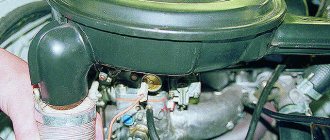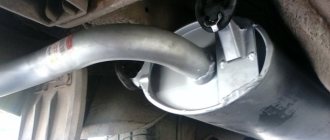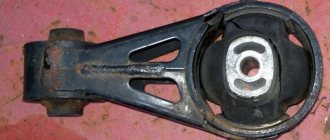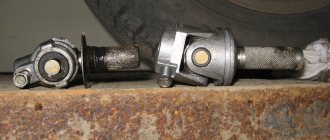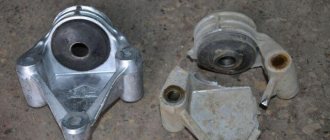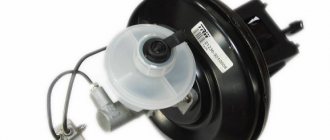Many owners of Lada cars are thinking about how to install forward flow on a VAZ 2114. This may be caused either by a desire to increase power or by a desire to give the car a more individual, sporty look. Be that as it may, doing it yourself is quite simple. We will tell you exactly how in today’s article.
Direct flow vaz 2114
Which muffler should I put on the VAZ 2114?
Which muffler should I put on the VAZ 2114?
Are you tired of repairing or changing the muffler on your car, and are asking yourself the question which muffler is better for the VAZ 2114?
In this article we will try to find out how to choose a muffler for a VAZ 2114, and which muffler is better to put on a VAZ 2114? First, let's find out what the exhaust system of the VAZ 2114 consists of, and why does the muffler have to be changed so often? The exhaust system of this VAZ model consists of (the list does not include gaskets and fasteners):
- intake pipe;
- catalytic converter (catalyst);
- oxygen sensor;
- additional muffler (resonator);
- exhaust system connecting pipes;
- main muffler;
- exhaust pipe.
The thinnest metal is used in the resonator and muffler, since they bear the least vibration and temperature loads, especially on the muffler. However, thin-walled exhaust elements are most susceptible to corrosion and exposure to salt in the winter, which leads to the rapid need to replace them. The muffler was developed at the factory as a consumable item rather than as a part designed for long-term use. But the need to replace it after half a year is very unpleasant financially and labor-intensive, hence the question arises, which muffler would be best to install on the VAZ 2114?
Muffler VAZ 2114, which one to choose?
All standard factory or factory made stock mufflers are not designed to last long, up to 3 years to be exact.
And this is a rather optimistic figure. However, different muffler options from different manufacturers will vary in quality. And this will also determine how much the exhaust system for a VAZ 2114 costs. And so what quality mufflers are there, and how much does a muffler for a VAZ 2114 cost in this regard:
- the cheapest option is thin-walled mufflers of dubious manufacture, as a rule, they are very light in weight and have a service life of six months;
- budget options - standard steel thickness (about 1.2-1.5 mm of the walls of the muffler can), service life up to 2 years;
- budget options with anti-corrosion coating - standard stock mufflers made of aluminized or galvanized steel, service life 2-3 years, with constant use of the car;
- above the standard price - mufflers made using stainless steel or corrosion-resistant steel, service life up to 5 years;
- expensive branded mufflers made entirely of stainless steel, service life more than 5 years.
An important criterion is how much a VAZ 2114 muffler costs. If you want to avoid having to buy and replace a muffler for a long time, then there is no point in saving. If you read reviews about the different types of silencers presented on our market, you can understand which silencer is better for the VAZ-2114.
And one more thing, often car owners try to install a muffler from another car, for example, install a VAZ 2105 muffler on a VAZ 2114, or from an Audi, Saab, etc. This is not recommended.
- firstly, you will disturb the exhaust configured at the factory;
- secondly, you will have to redo the exhaust mounting system, which often has a negative impact on the lower part of the body.
But if you decide to redo it, then you can try installing a direct-flow quiet exhaust.
Which forward flow should I put on the VAZ 2114?
It’s worth mentioning right away that it is better to install a high-quality direct-flow exhaust system with an original sound that does not exceed the noise standards established in our country.
This, of course, will depend on how much direct flow on a VAZ 2114 costs, but in this case you shouldn’t go too cheap. Straight-through (sports) mufflers are conventionally divided into two categories:
- direct flows designed for installation in a standard place and under the factory mounting system, without the need to modify the rear bumper;
- direct flows that require modification of the exhaust system, fastening system and/or rear bumper of the car.
How to install forward flow on a VAZ 2114 will depend on which muffler model you choose.
High-quality straight-through stainless steel mufflers will serve you for many years, although they are expensive. More budget models are designed to last from 3 to 5 years, but this is also quite a long time, judging by the general service life of mufflers on our market.
Resonators for VAZ 2113, 2114, 2115 — Select
Making and installing a flute
The flute (silencer) has more preferable characteristics. It dampens the exhaust pipe clearance much less than a damper. You can buy a flute, knowing the internal diameter of the outlet pipe, or make it yourself. Various silencer designs are shown in the photo.
Flute mounting options
Possible versions of the flute.
- External - for outlet pipe diameters up to 50–60 mm.
- Internal - for large diameters. The diameter of the smaller pipe should be 15–40% smaller than the diameter of the outlet pipe, the length should be from 0.25–0.35 m to 0.50–0.75 m. As a rule, unloading holes are made in it.
- To improve sound insulation of the exhaust, it is possible to wrap the flute with mineral wool. We protect it from blowing out around the perimeter with a fine metal mesh, as we did on a direct-flow muffler. In this case, the loss of engine power will be more noticeable, but the engine will operate more stable than with the throttle closed.
Tools and materials for making a flute
- Bulgarian;
- electric drill;
- welding machine;
- spanners.
It is better to choose blanks from stainless steel with a thickness of 0.8–1.2 mm, which guarantees long service life. Blanks made of “ferrous” metals are acceptable with a thickness of 2.0–2.5 mm or less if we plan to use the flute for short periods. As blanks we use two pieces of pipe and sheet metal for the flange.
Making a flute with your own hands
The order of work performed:
- We adjust all parts to the required dimensions. We measure the dimensions of the flange and larger pipe “on site”.
- We drill holes.
To further relieve the exhaust system from excess exhaust gas pressure, holes are drilled in the flange.
- We clean it and prepare it for welding.
- We weld the parts ourselves or with the help of a welder and clean the seams.
Diagram for 1.6 l engines
The exhaust system of cars equipped with 1.6 liter engines is distinguished by the fact that it does not contain a neutralizer; this element is replaced by a metal “corrugation”. The exhaust system of the 1.6-liter VAZ 2114 is also equipped with a catalytic manifold, which is mounted after the sealing gasket (3). Let's add a few words about the fastening of the entire structure - it is suspended from the bottom of the car on five suspension cushions, and its component parts are connected to each other using gaskets, O-rings and clamps. And some more information for your information - the exhaust system of VAZ 2115, 14, and 13 has a toxicity standard of R 83.
Exhaust system connecting parts
- the sealing gasket serves to connect the manifold and the exhaust pipe;
- a movable hinge connects the converter flange and the exhaust pipe;
- the metallographic ring is located between the flanges;
- the connecting parts between the muffler pipes are a clamp with flared ends and conical rings;
- the exhaust pipe is secured with DISPOSABLE nuts to the studs of the exhaust manifold and to the walls of the bracket.
Mufflers and pipes are a single system, and if they break down, the entire muffler device must be replaced with new ones.
Results of installing a direct-flow muffler
By converting the muffler to direct flow, you will receive the following advantages:
- increase in power (on average - by 5-10 hp);
- more aggressive exhaust sound (especially at high speeds);
- a slight increase in maximum speed.
At the same time, it is worth understanding that for the most part, installing direct flow gives the car individuality, but does not make colossal changes to its characteristics. It will not be possible to achieve a sharp increase in the maximum possible speed or acceleration to hundreds in 10 seconds by simply modifying the muffler.
A little theory
Muffler operation diagram
Tuning the exhaust system is one of the main components of the sporty modification of VAZ cars. With a standard exhaust system, the engine does not realize its full potential. It's a matter of exhaust design. The internal part of the muffler is made in the form of several tubes that disperse the flow of exhaust gases.
Some of the power is lost at the muffler "bank". Converting the muffler to direct flow allows you to slightly reduce losses.
The best result is obtained in combination with other measures: removal of the catalyst and chip tuning, which optimizes the operation of the lambda probe for the new exhaust system. Making changes to the exhaust design changes the amount of oxygen in the exhaust gases. With standard computer settings, injection will not work correctly.
Results of installing a direct-flow muffler
By converting the muffler to direct flow, you will receive the following advantages:
- increase in power (on average - by 5-10 hp);
- more aggressive exhaust sound (especially at high speeds);
- a slight increase in maximum speed.
At the same time, it is worth understanding that for the most part, installing direct flow gives the car individuality, but does not make colossal changes to its characteristics. It will not be possible to achieve a sharp increase in the maximum possible speed or acceleration to hundreds in 10 seconds by simply modifying the muffler.
Damper installation
The damper is installed either before or after the muffler. The volume of the forward exhaust will be clearly reduced only when the damper is completely closed. Technological clearances of 3-5% remain for the passage of exhaust gases - so the engine does not stall. In this regard, engine power is significantly reduced due to blockage of the exhaust system.
A damper is also used to switch from a direct-flow to a return-flow muffler and vice versa, if necessary. In this case, a new muffler is installed parallel to the old one, and the damper is mounted in front of them. This scheme is already used on some brands of cars from the factory.
You can drive a short distance with the throttle closed, but driving constantly is unacceptable for the engine.
Symptoms of a problem
The car itself will tell you when the muffler needs to be replaced. You just need to listen for the characteristic signs of its malfunction:
- Noise increases when the engine is running;
- There is an exhaust smell inside the cabin or near the car;
- Exhaust gas smoke comes out from under the bottom due to the formation of a hole in the exhaust system.
Reasons for muffler failure
There can be only two malfunctions of the muffler: burning out of the housing and its damage caused by corrosion processes or mechanical stress. In the first case, the cause is other malfunctions of the exhaust system, for example damage to the catalyst or resonator, as a result of which the gases are not cooled enough. In addition, in the VAZ-2114 the muffler may suffer due to:
- frequent temperature changes (driving on water, snow);
- significant pollution;
- mechanical damage;
- long-term operation without proper maintenance.
Tuning the gas exhaust system
The exhaust system of the VAZ 2114 also allows you to increase the power of the vehicle's power unit thanks to the installation of forward flow. The engine is boosted by accelerating the exhaust gases.
The principle of operation of direct-flow systems involves the creation of a rarefied atmosphere in which flows flow faster from the combustion chamber into the fuel cylinders. Increasing speed proportionally increases power, creating the necessary resistance.
Its value reaches about 10% above what is initially included in the technical characteristics of the exhaust unit without a direct-flow unit.
In a standard muffler, the resistance rate is much higher - 60-70%, which significantly slows down the release of exhaust gases. Equipping with such a unit also increases engine power by 6%. It is important to note that this happens without any structural changes to the gas exhaust system, which often require substantial investment.
Assembling a direct flow in the body of an old muffler
If for one reason or another you are not satisfied with the option of purchasing a ready-made direct-flow muffler, there are two options for creating it yourself:
- assembly in the body of an old muffler;
- construction of a new part.
The first option is simpler and cheaper. To carry it out, relatively straight arms and a welding inverter are enough. The advantage of this method is the minimal impact on the computer settings for the oxygen sensor and a slight (if assembled correctly) change in engine noise. The sound will become more bassy at revs, no more.
Ready homemade forward flow
- Remove the old muffler and cut out a full-length window in the body.
- Remove contents and outlet pipe.
- Make and weld into the muffler a “flute” from a perforated pipe or an ordinary pipe, in which cuts are made with a grinder or holes are drilled with a drill. This design disperses the flow of gases, reduces noise and exhaust temperature.
- Weld the exhaust pipe. For aesthetics, you can use a single or double chrome pipe. Perforate the part that is inside the muffler with a drill.
- It is advisable to fill the muffler with mineral wool. You can also use asbestos sheet, glass wool or other heat-resistant material.
- Weld the window in the housing.
To minimize the carryover of filler through the holes in the perforated pipe, it can be pre-wrapped with a metal mesh.
Videos about the muffler
There are many videos on the Internet in which the authors inventively and simply demonstrate how to make a direct flow with their own hands.
Video: how to make a straight-through muffler with your own hands
Another clear example of making a muffler from scratch. The straight-through version is made of stainless steel with two exhaust pipes.
Video: how to make a straight-through muffler from stainless steel
https://www.youtube.com/watch?v=zhxpX0O7E8s
Official recommendations
Naturally, the manufacturer recommends installing silencers made by AvtoVAZAgregat of the appropriate modification. The recommendations are justified by the following arguments:
- Compared to competitive products, jammers weigh more. According to factory workers, this means that their walls are thicker and will last longer (3-5 times, according to the manufacturer).
- The insides of the muffler are filled with special cotton wool, which collects condensation and prevents it from causing corrosion.
Replacing a return flow muffler with a direct flow one with your own hands
When manufacturing a direct flow, it is advisable to use the positive properties of several types of structures.
Reasons for replacing a standard muffler with a direct-flow muffler
Car owners change the factory muffler to a direct flow one for several reasons:
- obtaining an increase in engine power;
- subjective improvement of acoustic parameters of the exhaust;
- increasing the aesthetic parameters of the car;
- complete modernization of the exhaust channel;
- The installed muffler has failed.
Tools and materials for work
A direct-flow muffler is often purchased, but for lovers of tools and an insatiable thirst for creativity, we recommend making it yourself. It is preferable to make parts from stainless steel with a thickness of 0.8–2.0 mm. Select ferrous metal blanks with a thickness of 1.0–1.5 mm for the case, the rest 2.0–4.0 mm to avoid premature burnout of parts, and also use standard blanks. For the body, use a suitable size: a fire extinguisher, a thermos, an empty gas or scuba cylinder.
To fill the muffler chamber, non-flammable porous material or a combination of them is used:
- basalt or other mineral wool;
- fine mesh metal mesh;
- metal mesh for the kitchen;
- metal shavings.
- angle grinder (grinder);
- drill or drilling machine;
- welding machine;
- consumables: metal discs for grinders, drills, electrodes, etc.
Reworking an old muffler
- We dismantle the old muffler, disassemble it using a grinder, leaving the body parts and the inlet pipe. While preserving the partitions, we drill holes in them for the passage of exhaust gases. The cameras further reduce exhaust volume.
- We perforate the inner pipe in an accessible way. The diameter of the perforated pipe is equal to the diameter of the inlet pipe or more up to 30%.
Keep in mind that mineral wool fibers will be “blown out” of the chamber faster through large holes and grooves.
In the future, the diameter of the inner pipe can be reduced by simple manipulations, but increasing it is disproportionately more difficult.
- We put metal mesh for the kitchen in place of the perforation of the pipe.
- Wrap the kitchen mesh tightly with metal mesh in 1-3 layers. We fix the mesh with annealed steel wire with multiple twists or crimp it with several clamps.
- We coordinate and clean the welding points, weld the perforated pipe into its regular place.
- We fill all free space inside the muffler tightly with the selected filler.
Working with mineral wool requires personal protective equipment.
- We grab the edge of the “lid” of the body with two or three tacks to avoid displacement and weld the body.
- To protect against corrosion and give it an aesthetic appearance, we paint it with heat-resistant paint in your favorite color.
- We install it on the car. We start the engine. We rejoice!
- To make the muffler last longer, we drill one or more holes with a diameter of 1.5–2.0 mm in the housing to drain condensate. To determine the lowest point, the car must be horizontal.
Types of mufflers and their differences
There are 4 types of mufflers based on the method of absorbing acoustic waves:
- reflective;
- restrictive;
- absorption;
- resonator.
The reflective circuit is reverse-flow, the rest are direct-flow.
Reflective
If one muffler is installed in a car, then a reflective version is used. It uses the principle of “breaking” the flow of exhaust gases by creating several partitions, expansion chambers and turns. Exhaust volume is reduced to standard levels. For this reason, the vast majority of factory vehicles are equipped with the reflective type.
The disadvantage of this type of muffler is the reduction in engine power due to the resistance of the exhaust system to the flow of exhaust gases.
Resonator
A resonator muffler is installed as the first stage in the exhaust system of powerful engines. It consists of a perforated pipe placed in a housing. The body is divided into two or three sections. The energy of the exhaust gases is weakened due to a stepwise reduction in pressure.
The part reduces the force of sound vibrations and maintains engine power with a free flow of exhaust gases.
Restrictive
In restrictive mufflers, the gas flow passes through a diaphragm or cone narrowing, which leads to a decrease in engine power. The acoustic protection of such devices is low, since the diaphragm does not interfere with the rectilinear movement of the sound wave.
Absorption
The damping function for sound vibrations in the absorption muffler is performed by a finely porous non-flammable material located in the space between the perforated pipe and the housing. The design is similar to the resonator type. This type has little effect on power reduction.
ABOUT SIGNS OF PROBLEM
As soon as there is even the slightest suspicion of problems with the exhaust tract, it is necessary to take measures to identify and eliminate these suspicions. Driving with a faulty muffler can cause problems from neighbors and traffic police.
You should be alert to the following manifestations in the operation of the exhaust system:
- The appearance of increased noise from a running motor;
- The presence of exhaust odors near the car, and in some cases in the cabin;
- The appearance of smoke from burnt-out exhaust elements under the bottom of the car;
There is no need to put off solving this problem. Take a few minutes to locate and determine the breakdown. After this, a decision is made to eliminate it. There can be only two options here: repairing the muffler or replacing the VAZ 2114 muffler.
How to choose?
It’s worth figuring out how to choose the right double exhaust for a VAZ 2114; to do this, you can use the following tips:
- It is necessary to take into account the sequence, the greater the weight of the product, the better. That is why the main attention should be paid to the choice of weight and quality of material.
- It is also important to evaluate the quality of the seams; they should not be too thin, but they should be even.
- The length of the product, as well as the attachment point to the body, needs to be assessed whether it is sufficient.
- Evaluate how thoroughly the areas of the product are painted; if the paint chips, it is better to refuse the purchase. This is a sign that the product is susceptible to corrosion and will not last for a long time.
A thorough assessment of the build quality and reliability of the fasteners will save you from unpleasant surprises on the road in the future and guarantee a long service life of the exhaust.
How to repair a “glushak” with your own hands
The muffler on the “fourteenth” and “fifteenth” is considered one of the most vulnerable points of the car. The fact is that due to exposure to high temperatures, the metal quickly burns out, that is, the tightness of the system is broken. Therefore, the part must be changed as soon as there is a suspicion that it is not working.
Reasons for failure
Most often, mufflers “burn out” - that is, due to hot exhaust, the metal inside the housing begins to thin out, which ultimately leads to the appearance of holes. However, this is not the only reason why the silencer may fail:


